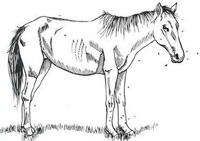Tracking Clinical Signs
Not every horse owner has the resources for serial testing - repeated blood work or imaging - to judge the effectiveness of a medication or treatment and may need to learn how to objectively use clinical signs to assess their horse's progress.
We sometimes underrate clinical signs and become obsessed with test results. In medicine, we often say "treat the patient, not the numbers". While lab or imaging results are necessary in many instances for a specific diagnosis or to determine an appropriate antibiotic, for example, an objective review of clinical signs can often give us the information we really need. We all know an "old time" vet or physician who is always spot on without running a battery of tests.
Several years ago I suggested using a "0 to 10" assessment scale to help a horse owner use clinical signs in evaluating the effect of titrating her horse's pergolide dose.
"So, take some paper and write down (really write it down, as a week from now it will be fuzzy) his overall appearance, how much back sag he has, if his eyes are clear or goopy, his coat condition, etc. being as objective as you can.
Rate his attitude on a scale from 0 to 10 (0 depressed, lethargic - 10 happy,curious), his activity (0 lying down all the time - 10 galloping with tail flagged), your assessment of his hoof pain (0 can't put weight on foot for trimming - 10 sound on gravel at trot, maybe a 5 for sound at a trot in boots), sweating (0 for anhydrosis - 10 for excessive sweating).
Put a brief word description next to each score to remind you exactly what you meant when you re-score him in a few days or a week. Take a picture or two to go with, put the pages away in his notebook.
Do this again in 4-7 days and compare it to the first assessment, then decide if you feel his medication should be increased or if he's shown improvement and you'll hold steady."
If you've made changes (in medication, treatment, etc.) and don't see improvement, it should cue you to review
other basics - diet, teeth, parasites, ulcers, foot pain, etc. and perhaps review the diagnosis and treatment plan.
It's a good idea to do our follow up assessment before looking back at the previous one as this will help us do an objective assessment. If you've never used a 0-10 assessment scale, it may feel awkward at first (which is why its helpful to include a descriptive word or two).
The Clinical Signs Tracker chart (view or download below) can be use for tracking your horse's progress. On the first page, I've entered several clinical signs related to Insulin Resistance/Metabolic Syndrome and PPID (Cushing's disease) but which also apply to other conditions. The second page was left blank so you and your veterinarian can list other clinical signs you may want to track for other problems or injuries, such as increase or decrease in swelling, lameness/soundness during rehab, changes in a wound size or drainage.
Providing an ongoing objective assessment record can be a valuable tool for working with your veterinarian and keep both of you from guessing if a treatment is effective.

